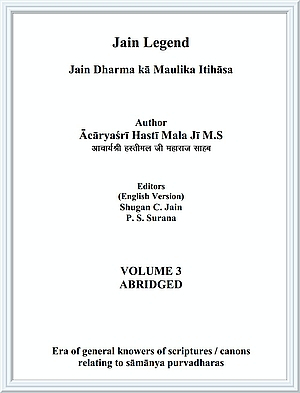In the first volume (Tīrthaṃkara khaṇḍa) of this series on history; history of Jain religion, from the beginning of present era and prehistoric times, starting with the founder of human civilization, the first Tīrthaṃkara Lord Vṛṣabha Deva to the liberation of 24th Tīrthaṃkara Lord Mahāvīra had been described. In the second volume, Jain history after the liberation of Lord Mahāvīra to his first disciple Indrabhuti Gautama, his first pontiff Ārya Sudharmā till 27th pontiff Devardhigaṇi Kṣamāśramaṇa i.e. a span of 1000 years had been presented.
Now in this third volume we are briefly presenting history of Jain religion along with prevailing political and social environment for the period V.N. 1001 to V.N. 1475.
To enable even a casual reader interested in knowing the history of Jainism since beginning and retain the same in his mind, we have divided history of Jainism in the following six parts:
- From the time of first Tīrthaṃkara to 24th Tīrthaṃkara. This is called as the era of Tīrthaṃkaras
- From the time of 1st pontiff of the creed of Lord Mahāvīra i.e. Ārya Sudharmā till the liberation of Ārya Jambū, the last omniscient i.e. the period of 63 years after the liberation of Lord Mahāvīra. This is period is called the era of omniscient lords.
- V.N. 63 till V.N. 170 i.e. period starting from Ācārya Prabhava to Bhadra Bāhu. This is called as the era of Śrutakevalīs or the all prior canons knowing pontiffs.
- V.N. 170 to V.N. 584 i.e. from the time of Ārya Sthūla Bhadra till Ārya Vajra. This period is called as the era of ten prior canons knowing (Daśapūrvadhara) pontiffs.
- V.N. 589 till V.N. 1000 i.e. the time from Ārya Rakṣita. This period is known as the era of partial knower of prior canons (Sādhāraṇa pūrvadharas).
- The period from V.N. 1000 i.e. after Ārya Devardhigaṇi Kṣamāśramaṇa till the last ācārya of this avasarpiṇī araka in Bharata region, namely Ācārya Duḥ Prasaha. We are identifying this period as the partial knower of scriptures (Sāmānya Śrutadhara).
In this third volume, we are planning to bring out the history of Jainism for the period starting from the departure to heavenly abode of Ārya Devardhigaṇi Kṣamāśramaṇa (V.N.1000) to the time of 47th pontiff of Lord Mahāvīra's congregation Ācārya Kalaśa Prabha, then up to the period till Lokāśāha in the fourth volume and finally from that period thereafter in the fifth volume.
History of Jain religion from the time of its 1st Tīrthaṃkara Lord Vṛṣabha Deva till heavenly departure of Ārya Devardhigaṇi Kṣamāśramaṇa had seen almost a unified congregation (barring a few minor aberrations during the time of Ācārya Mahāgiri and Ācārya Suhasti) adhering to the doctrine and conduct as propagated by 24th Tīrthaṃkara. Even though the unified congregation was divided into five sects namely, Digambara, Yāpanīya, Śvetāmbara, Temple dwellers and Bhaṭṭāraks; the doctrine and conduct was followed by majority of Jains remained the same as originally propagated by Tīrthaṃkaras till V.N. 1000. Thus the original doctrine and conduct continued to flow during this period like a primary river with other sub divisions and sects as its tributaries. But the state of Jainism, after the death of Devardhigaṇi Kṣamāśramaṇa, being divided into many sects and congregations was very different than what it was originally. It became very complicated and contrary to its original character. However, Jainism till V.N. 245 i.e. the death of Ācārya Mahāgiri continued as a unified and pure tradition of ācāryas as propagated by Lord Mahāvīra.
From V.N. 245 to V.N. 1000; even though the history of Jainism is replete with external divisions according to epochal, discourse and group or gaṇa ācāryas, yet the basic doctrine and conduct of śramaṇas and followers, like the confluence of three rivers, continued as unified and great tradition and religion.
During this period, management and conduct of the congregation of Lord Mahāvīra was led by the trio of epochal, discourse and group (gaṇa) ācāryas. These three different leaders continued to propagate the true doctrine as depicted in the scriptures (āgamas) while projecting a unified view of Jainism. They continued to take Jainism to its supreme state by enhancing the spiritual development of self, others and the congregation.
In this way, history of Jainism till V.N. 1000 shows that Jainism continued to be relatively easy to practice for spiritual development and stayed free from problems which could not be resolved. This is so even when this period was full of complications and controversies. As against this, history of Jainism after V.N. 1000 shows that the Jains were divided into many groups, communities preaching and practicing religion contrary to what has been said in the scriptures. Hence this period faced many complicated problems and contradictions due to the false propaganda and show of strength by these newly established pseudo groups and gacchas.
Complicated by the rise of these different groups and gacchas after Devardhigaṇi Kṣamāśramaṇa, history of Jainism is full of differences in doctrine and conduct as promoted and practiced by different groups and their practices in different parts of the country. Hence it became very complicated to depict the history of Jainism during this period.
 Acharya Hasti Mala
Acharya Hasti Mala
